Abstract
OBJECTIVES: Severe damage to skeletal muscle is usually seen in patients with exertional heatstroke. Thirty seven young military recruits with exertional heatstroke in Taiwan from 1992 to 1995 were studied to evaluate changes in muscle pathology and blood lactate with exercise. METHODS: A biopsy sample of the vastus lateralis was taken from recruits within 10 days of the initial presentation. Results were compared with those from 15 controls matched for age and sex. During the recovery period, 90-150 days after exertional heatstroke, 29 patients participated in a constant work load test on the treadmill to assess their blood lactate threshold, and a second biopsy sample was taken. Each biopsy was examined histologically for pathology, distribution of fibre types, and fibre diameter. RESULTS: Twenty four of the 37 patients with exertional heatstroke developed rhabdomyolysis and 18 of these had type II fibre predominance in their muscle biopsy. The patients with type II fibre predominance had a higher tendency to develop rhabdomyolysis (chi 2 = 6.84, P < 0.01). The time required to reach a blood lactate threshold during a constant treadmill work load after recovery was significantly shorter in the patients with exertional heatstroke who had type II fibre predominance (P < 0.01). There was a positive correlation between the highest value of blood lactate and the percentage of type II fibres in all tested subjects (r = 0.82, P < 0.01). CONCLUSION: Patients with type II fibre predominance are more susceptible to exertional heatstroke and tend to have a higher blood lactate concentration and a shorter time to reach blood lactate threshold under a treadmill load test.
Full text
PDF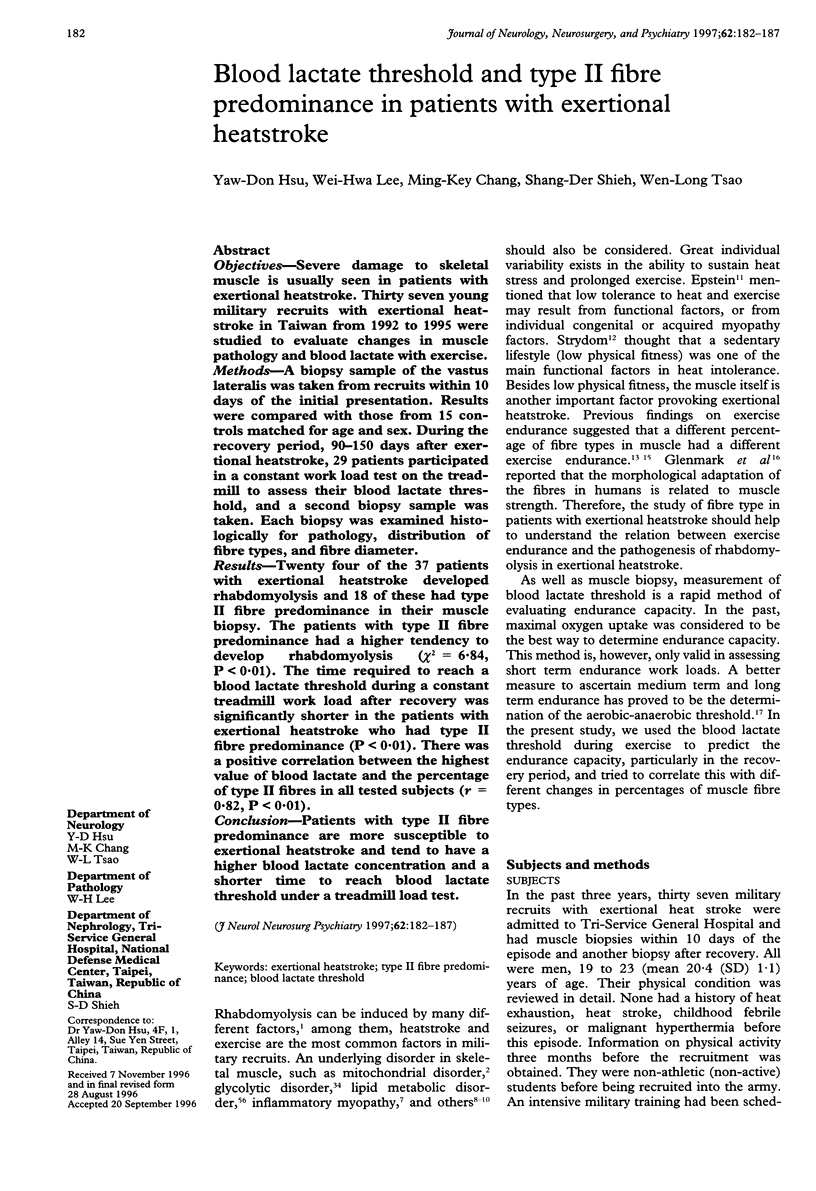
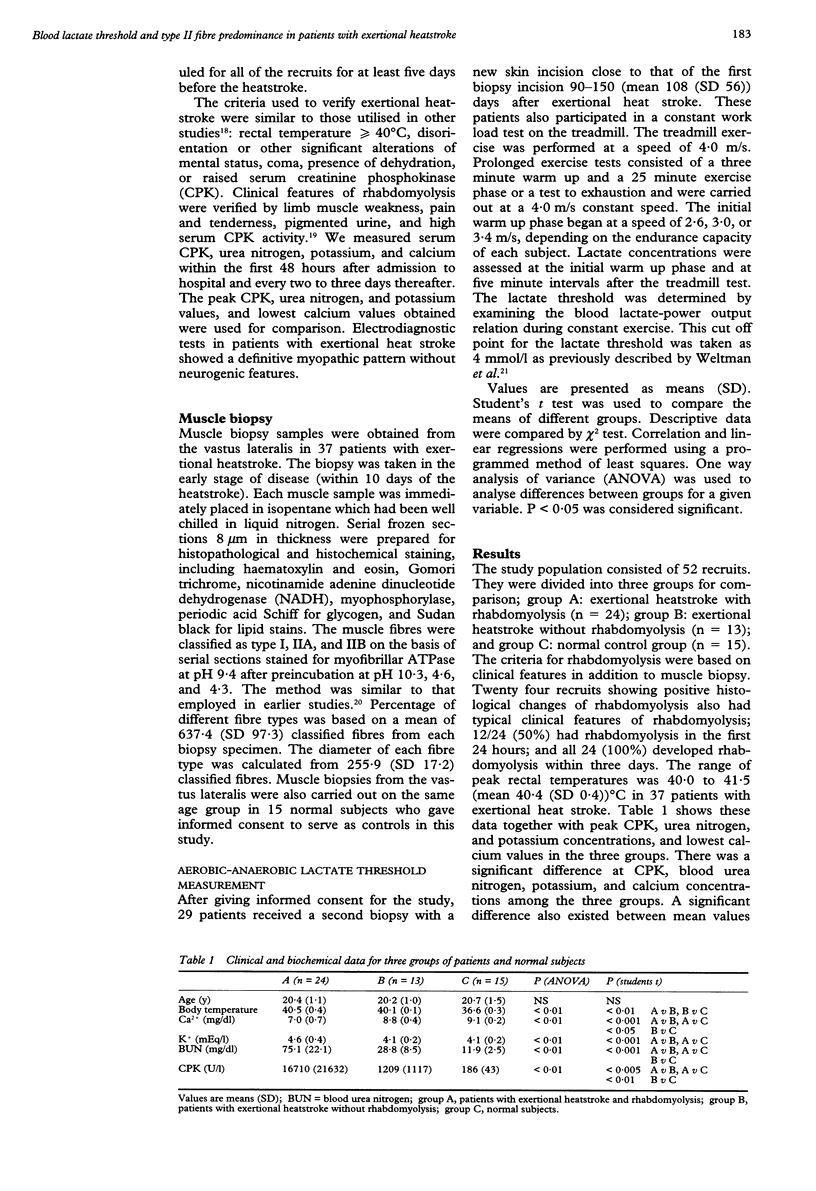
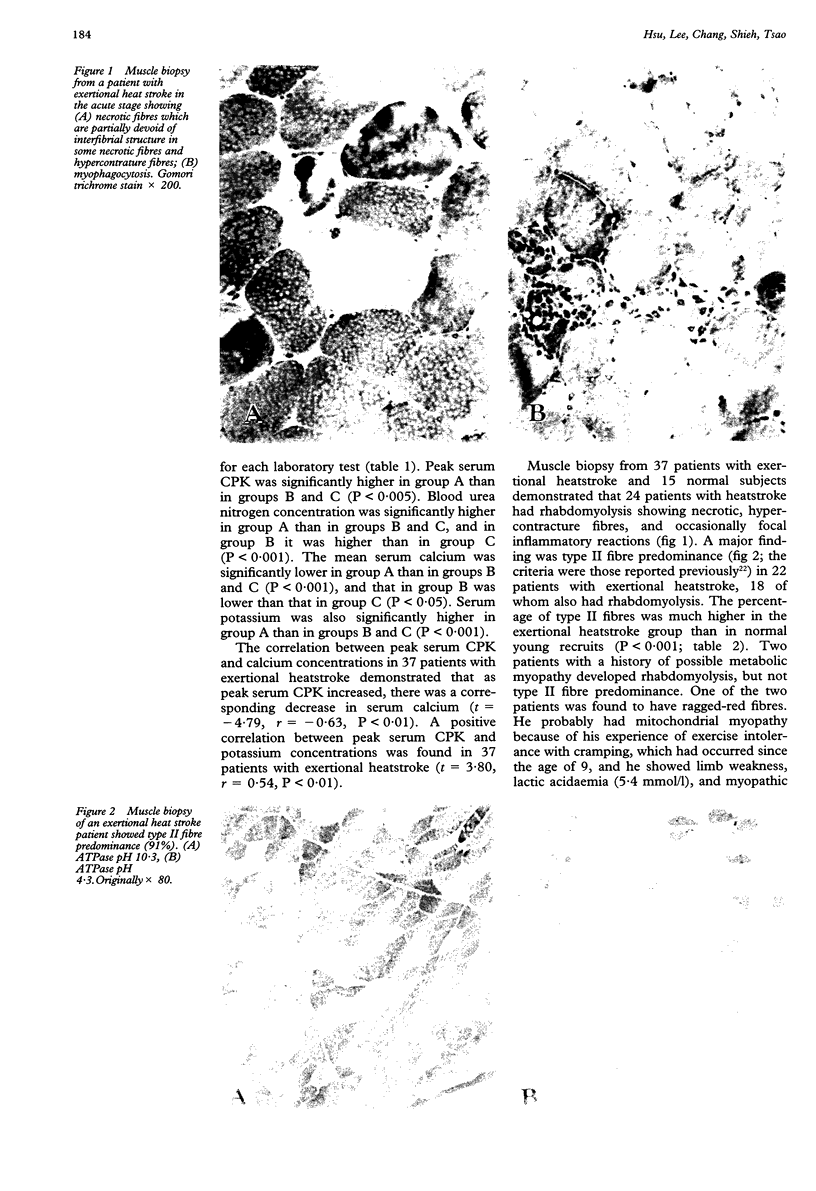
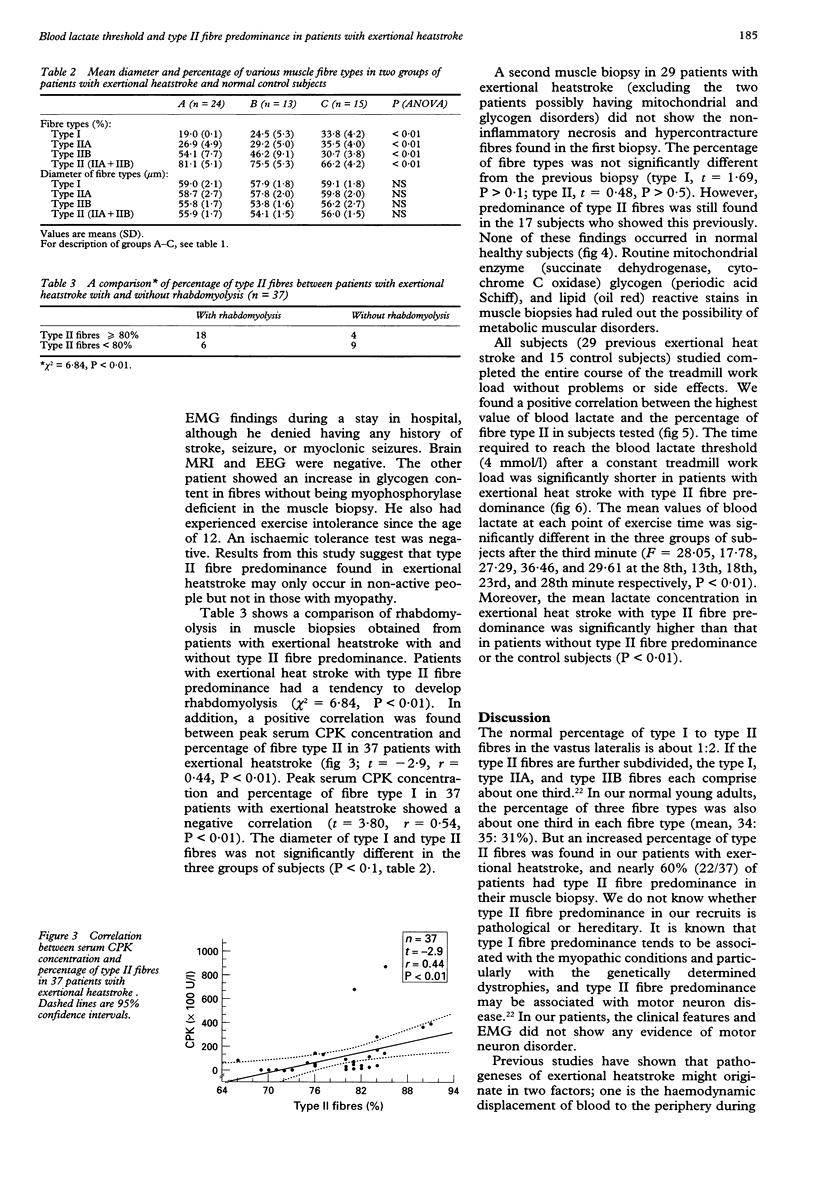
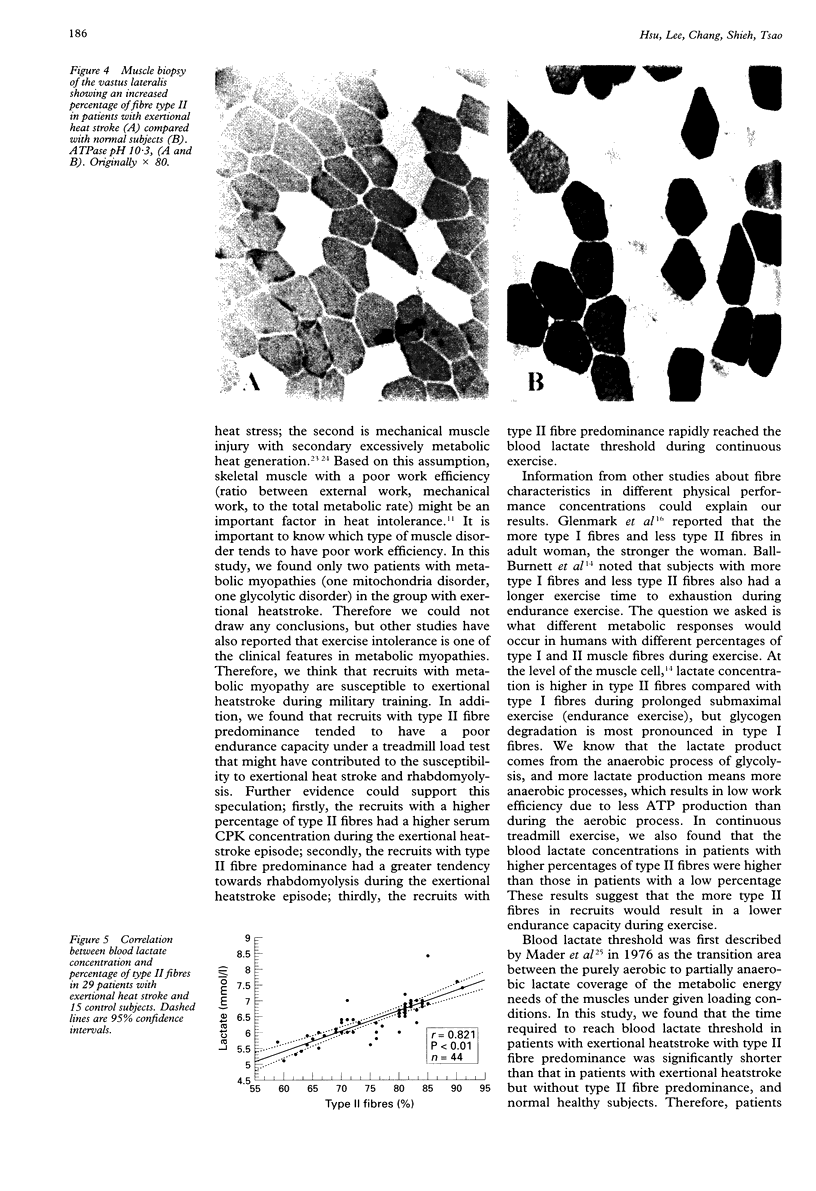
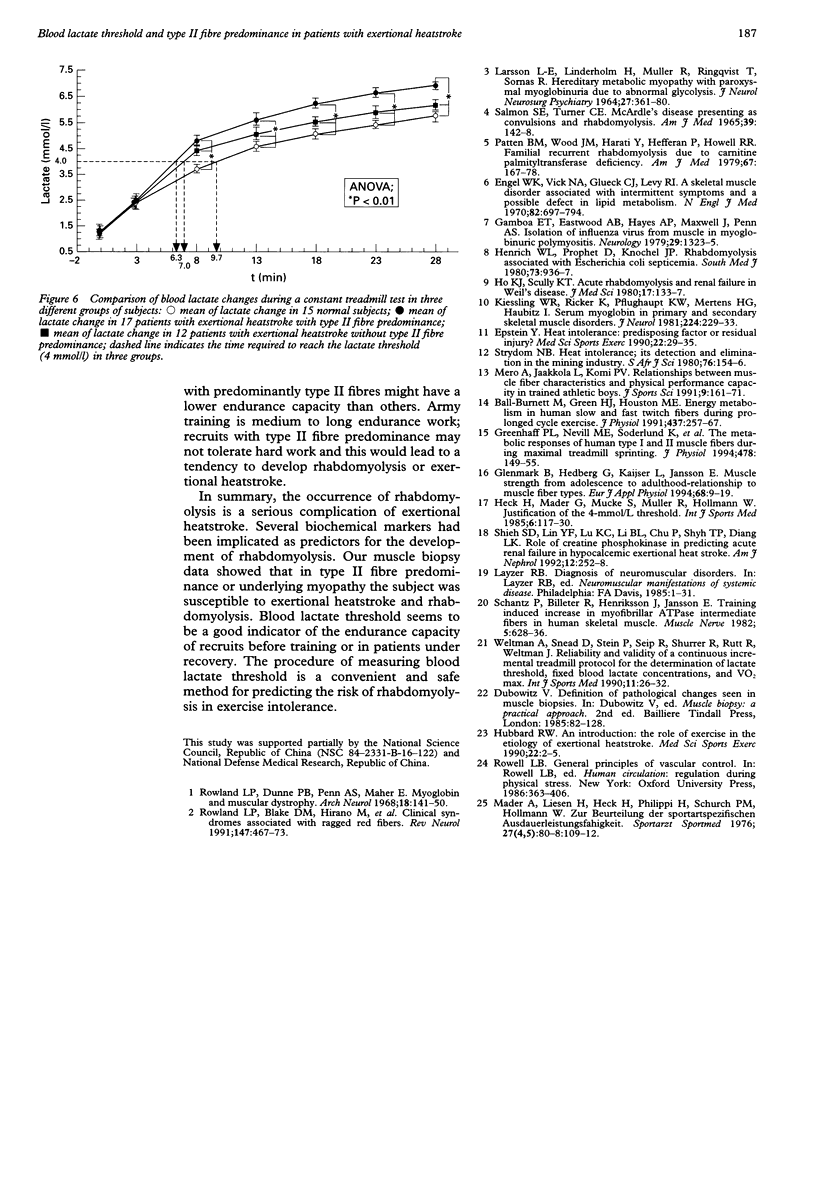
Images in this article
Selected References
These references are in PubMed. This may not be the complete list of references from this article.
- Ball-Burnett M., Green H. J., Houston M. E. Energy metabolism in human slow and fast twitch fibres during prolonged cycle exercise. J Physiol. 1991 Jun;437:257–267. doi: 10.1113/jphysiol.1991.sp018594. [DOI] [PMC free article] [PubMed] [Google Scholar]
- Engel W. K., Vick N. A., Glueck C. J., Levy R. I. A skeletal-muscle disorder associated with intermittent symptoms and a possible defect of lipid metabolism. N Engl J Med. 1970 Mar 26;282(13):697–704. doi: 10.1056/NEJM197003262821301. [DOI] [PubMed] [Google Scholar]
- Epstein Y. Heat intolerance: predisposing factor or residual injury? Med Sci Sports Exerc. 1990 Feb;22(1):29–35. [PubMed] [Google Scholar]
- Gamboa E. T., Eastwood A. B., Hays A. P., Maxwell J., Penn A. S. Isolation of influenza virus from muscle in myoglobinuric polymyositis. Neurology. 1979 Oct;29(10):1323–1335. doi: 10.1212/wnl.29.10.1323. [DOI] [PubMed] [Google Scholar]
- Glenmark B., Hedberg G., Kaijser L., Jansson E. Muscle strength from adolescence to adulthood--relationship to muscle fibre types. Eur J Appl Physiol Occup Physiol. 1994;68(1):9–19. doi: 10.1007/BF00599235. [DOI] [PubMed] [Google Scholar]
- Greenhaff P. L., Nevill M. E., Soderlund K., Bodin K., Boobis L. H., Williams C., Hultman E. The metabolic responses of human type I and II muscle fibres during maximal treadmill sprinting. J Physiol. 1994 Jul 1;478(Pt 1):149–155. doi: 10.1113/jphysiol.1994.sp020238. [DOI] [PMC free article] [PubMed] [Google Scholar]
- Heck H., Mader A., Hess G., Mücke S., Müller R., Hollmann W. Justification of the 4-mmol/l lactate threshold. Int J Sports Med. 1985 Jun;6(3):117–130. doi: 10.1055/s-2008-1025824. [DOI] [PubMed] [Google Scholar]
- Henrich W. L., Prophet D., Knochel J. P. Rhabdomyolysis associated with Escherichia coli septicemia. South Med J. 1980 Jul;73(7):936–937. doi: 10.1097/00007611-198007000-00032. [DOI] [PubMed] [Google Scholar]
- Ho K. J., Scully K. T. Acute rhabdomyolysis and renal failure in Weil's disease. Ala J Med Sci. 1980 Apr;17(2):133–137. [PubMed] [Google Scholar]
- Hubbard R. W. The role of exercise in the etiology of exertional heatstroke. Med Sci Sports Exerc. 1990 Feb;22(1):2–5. [PubMed] [Google Scholar]
- Kiessling W. R., Ricker K., Pflughaupt K. W., Mertens H. G., Haubitz I. Serum myoglobin in primary and secondary skeletal muscle disorders. J Neurol. 1981;224(3):229–233. doi: 10.1007/BF00313285. [DOI] [PubMed] [Google Scholar]
- LARSSON L. E., LINDERHOLM H., MUELLER R., RINGQVIST T., SOERNAES R. HEREDITARY METABOLIC MYOPATHY WITH PAROXYSMAL MYOGLOBINURIA DUE TO ABNORMAL GLYCOLYSIS. J Neurol Neurosurg Psychiatry. 1964 Oct;27:361–380. doi: 10.1136/jnnp.27.5.361. [DOI] [PMC free article] [PubMed] [Google Scholar]
- Mero A., Jaakkola L., Komi P. V. Relationships between muscle fibre characteristics and physical performance capacity in trained athletic boys. J Sports Sci. 1991 Summer;9(2):161–171. doi: 10.1080/02640419108729877. [DOI] [PubMed] [Google Scholar]
- Patten B. M., Wood J. M., Harati Y., Hefferan P., Howell R. R. Familial recurrent rhabdomyolysis due to carnitine palmityl transferase deficiency. Am J Med. 1979 Jul;67(1):167–171. doi: 10.1016/0002-9343(79)90099-8. [DOI] [PubMed] [Google Scholar]
- Rowland L. P., Blake D. M., Hirano M., Di Mauro S., Schon E. A., Hays A. P., Devivo D. C. Clinical syndromes associated with ragged red fibers. Rev Neurol (Paris) 1991;147(6-7):467–473. [PubMed] [Google Scholar]
- Rowland L. P., Dunne P. B., Penn A. S., Maher E. Myoglobin and muscular dystrophy. Electrophoretic and immunochemical study. Arch Neurol. 1968 Feb;18(2):141–150. doi: 10.1001/archneur.1968.00470320043005. [DOI] [PubMed] [Google Scholar]
- SALMON S. E., TURNER C. E. MCARDLE'S DISEASE PRESENTING AS CONVULSION AND RHABDOMYOLYSIS. Am J Med. 1965 Jul;39:142–146. doi: 10.1016/0002-9343(65)90254-8. [DOI] [PubMed] [Google Scholar]
- Schantz P., Billeter R., Henriksson J., Jansson E. Training-induced increase in myofibrillar ATPase intermediate fibers in human skeletal muscle. Muscle Nerve. 1982 Oct;5(8):628–636. doi: 10.1002/mus.880050807. [DOI] [PubMed] [Google Scholar]
- Shieh S. D., Lin Y. F., Lu K. C., Li B. L., Chu P., Shyh T. P., Diang L. K. Role of creatine phosphokinase in predicting acute renal failure in hypocalcemic exertional heat stroke. Am J Nephrol. 1992;12(4):252–258. doi: 10.1159/000168454. [DOI] [PubMed] [Google Scholar]
- Weltman A., Snead D., Stein P., Seip R., Schurrer R., Rutt R., Weltman J. Reliability and validity of a continuous incremental treadmill protocol for the determination of lactate threshold, fixed blood lactate concentrations, and VO2max. Int J Sports Med. 1990 Feb;11(1):26–32. doi: 10.1055/s-2007-1024757. [DOI] [PubMed] [Google Scholar]





